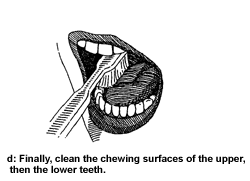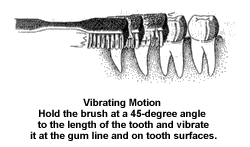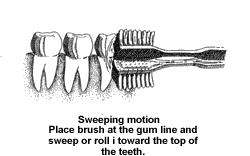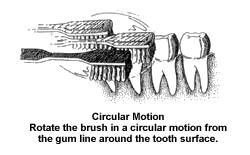The practice of proper oral hygiene is the most important thing you can do for your teeth and gums. In Part One, you learned that brushing alone is not sufficient to care for your teeth. In addition to brushing, your daily routine should include flossing and, depending on your particular need, the use of balsa-wood tooth-picks, gum stimulators, or water-irrigating devices.
Brushing
 |
 |
 |
 |
| Figure 3-10. Proper Brushing Sequence |
Proper brushing involves choosing and caring for your toothbrush as well as using it correctly. There are many different types of toothbrushes available, with a variety of sizes, shapes, and lengths. No single type is best for everyone, but soft bristles are recommended whether you use an electric or manual toothbrush.
Although electric toothbrushes are effective in plaque removal and gum stimulation, they have no proven advantage over manual toothbrushes. Some people, however, simply prefer them. Handicapped individuals, those who wear braces, and lazy children may also benefit from using electric toothbrushes.
If you use a manual toothbrush, choose one with a handle that is easy to manipulate. Small-headed brushes are preferable since they have better access to all areas of the mouth. Nylon and natural bristles are equally satisfactory, but natural bristles may not last as long as nylon. Toothbrushes should be replaced every month and whenever the bristles begin to bend or fray. It is also very important to change toothbrushes after recovering from a cold or other respiratory infection since the bristles may harbor the harmful organisms.
Kept in a moisture-rich environment such as a bathroom, toothbrushes tend to harbor bacteria. Store your toothbrush in a solution of hydrogen peroxide or rubbing alcohol. Replace the solution when it begins to appear cloudy.
Now that you know how to care for your toothbrush, turn your attention to proper brushing technique. How thorough you are in your brushing is more important than how hard you brush. Follow a specific brushing sequence as shown in Figure 3.10. Begin by brushing the outside surfaces (cheek and lip side) of the upper, then the lower teeth. Start with the back teeth on one side and work your way around to the other side. Next, brush the inner surfaces of first the upper teeth, then the lower teeth. Finally brush the chewing surfaces. The key is to take your time. It is more important to brush thoroughly once a day than to brush quickly and haphazardly three or four times a day. Take at least three minutes to brush your teeth. Brush so that you are cleaning every side of every tooth: outside (cheek side), inside (tongue or palate side), and chewing surfaces.
 |
 |
 |
| Figure 2-11. Brushing Techniques |
There are three acceptable brushing methods as illustrated in Figure 3.11; but, no matter which technique you use, as stated earlier, the key is how thorough you are, not how hard or how many times you brush. All of the following brushing techniques are acceptable:
- Place the head of the brush at a 45-degree angle to the length of the tooth. Gently vibrate the toothbrush at the gum line and on the surfaces of each tooth.
- Place the brush at the gum line and roll or sweep it towards the top surface of the tooth.
- Rotate the brush in a circular motion on the gum line and the tooth surface.
- In all of the above methods, the gums as well as the tongue should also be brushed as they harbor bacteria.
Flossing
Plaque build-up, which can lead to tooth decay and gum disease, cannot be removed from teeth by brushing alone.
Regular flossing cleans away plaque and food particles from those areas between teeth that the toothbrush cannot reach. Flossing is also an important tool for preventing gum disease. However, if the gums between the teeth have become flat, are severely receded, or have formed deep pockets, flossing will not be effective.
Several types of dental floss are available. Unwaxed floss is thinner than waxed and is best for getting into tight areas; however, unwaxed floss does fray more easily than waxed. Although the unwaxed variety is more effective in removing plaque, waxed floss is easier to handle if rough fillings are present or if teeth are very close together. Waxed floss also comes in a variety of flavors. Dental tape is a flat, wide floss that is used in areas where large spaces exist between teeth. Johnson